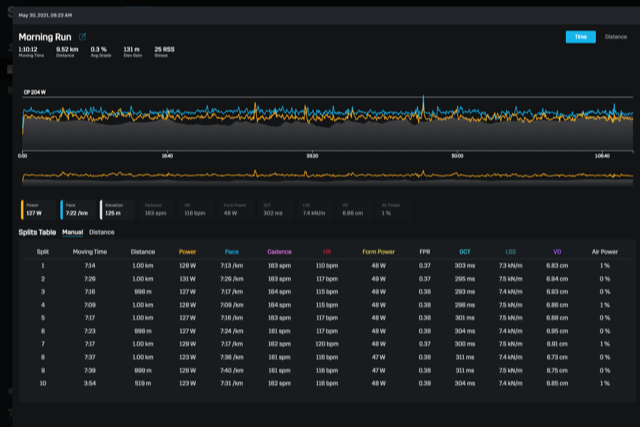
Many individuals track their training. Fewer track their recovery. Tracking both is important in optimising training.
Many people who exercise wear heart rate monitoring devices. Some wear step counters. Others use GPS-enabled sports watches that do all of the above plus track the training session in some detail so there are lots of ‘stats’ and pretty pictures with pace, effort, efficiency etc. etc. However, how many of us keep a simple record of stats that provide useful information on how we are tolerating our training and recovering from it? Those who do, gain insights that help them match the training to their ability to tolerate it, day by day, so that the session on any given day is the one that they can actually benefit from. Without a training diary, it’s more like guess work! Reaching our training goals becomes more reliant on chance and we are in a poor position to anticipate or avoid predictable bumps on our training journey (e.g. injuries, illnesses, over-training)
OK, you may say, that’s all well and good for the serious athletes, the elite. What about normal recreational exercisers? Do we need to bother about training diaries? Isn’t Strava good enough for us?
The elites etc. have teams of coaches and advisors to guide them and they collect loads of data to use in this process of tailoring training to their individual needs. A training diary is a small part of their toolkit! Arguably the training diary is even more important for those of us who don’t have the sophisticated backup systems available to the elite. And, the good news is, it doesn’t have to be complex! A simple diary can be a really good way of helping us to collect some straightforward information which we can then use to help us judge if what we are doing is generally helping us make progress towards our goals.
Keeping a written (digital/paper) record involves noting down what we do day to day in terms of training (training load) and how we are tolerating it (recovery), plus the steps we are taking to help us recover (sleep, relaxation, nutrition & hydration, stretching/massage/other remedial activities). Then, we can consider the whole picture and be a little more informed in our decisions about what to do next so we move towards health & fitness and, if relevant, toward more specific ‘performance’ goals such as races. The training diary is just a means of injecting some rational logical thought into our training system. Clearly, more sophisticated digital systems exist to help us maintain a training diary (e.g. Training Peaks) and certain devices (e.g. Polar, Stryd, Garmin) can be used to record relevant data on sleep, power etc. These can be exploited to help us better judge how ‘ready for the next exercise session’ we are. However, the old style systems (pen & paper), a couple of insightful monitoring measurements, and honesty with ourselves about how we feel can also work well. So it doesn’t have to be expensive!
Using such a straightforward system we can record each day our:
Training
- duration of each type of exercise with its associated effort score using something like the modified Borg ‘rate of perceived exertion’ scale. For strength training a bit more detail may be required (kgs lifted and type of session). Remember ALL physical activity contribute to training load so, if we have been digging the garden for 3 hours, that’s a strength endurance session!
- how we felt before & after the exercise on a scale that means something to us (these are more sensitive metrics than many people think)
- if we have the data from a GPS-enabled device some straightforward stats like pace, distance, average heart rate (a somewhat useful measure of effort). For strength training, these data may not be very useful as heart rate is a poor measure of effort in such sessions.
- the purpose of each exercise session. This can really focus the mind a little on how each activity might be helping (or hindering) us on our training journey. So, that ‘faster than comfortable’ long run might have to be recategorized! Or that HIIT session in the gym that our friend persuaded us to go to, and sounded and felt like so much fun, might have left us absolutely exhausted. Next day, our legs might be so sore we skipped our cycling session. Since we have a record of the impact of that HIIT session, an invitation to go to another HIIT session might be viewed differently! ALL our sessions need to have a purpose that helps us move towards our goals. (Otherwise they are probably moving us away from those goals).
Recovery
- Our attitude to life/training early in the day once we are awake – this is a totally individual rating for each person but a simple 1-5 scale that is meaningful can be used!
- our resting heart rate taken when lying in bed (some wearable devices do this)
- How long we have slept for and a general impression of how well we have slept (some wearable devices do this for us)
- Whether or not we feel we have nourished and hydrated ourselves properly the previous day. The effects of problems in those areas may only be felt on the subsequent days but awareness of the possible need for change is the first step in making a change.
- How non-exercise aspects of life may be impacting our ability to recover – here I include extra busy/fraught workdays, family life etc. Basically, the ‘stuff’ that we all have to deal with all the time and which impacts our recovery, but it’s stuff we may try to brush off because, after all, we are a ‘man/woman on a mission to (insert race event here)’!! Too often ignoring the signals our bodies may be trying to give us means we don’t work productively with our multi-faceted lives. The result may be failure to make progress towards the goals that are important to us.
There are other stats that can be useful too but having some of the above in each of the training and recovery areas may be plenty to start with. After a few weeks or months of gathering information in our training diary, we may choose to adjust the amount of information we collect and review.
Day to day, we should look at the recovery versus the training and make any necessary adjustments to the scheduled training session in light of how well we have recovered from the previous session (and from life in general!). Having a formal weekly and monthly review of the information is important too in helping us to decide what, if anything, needs to change so that we continue to make progress.
